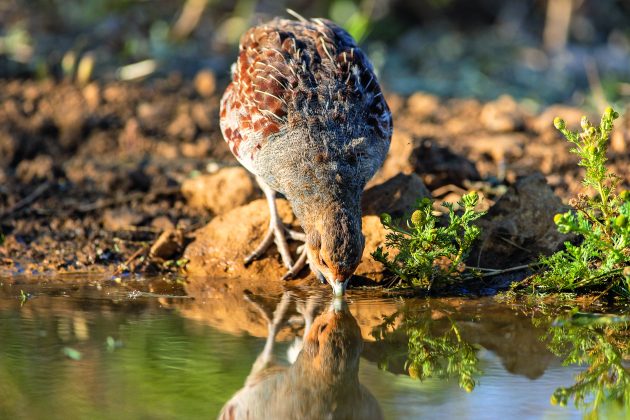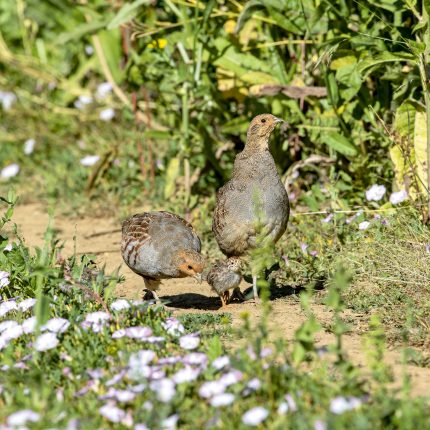Celebrating its 90th year, the GWCT Partridge Count Scheme holds the key to UK nature recovery, and you don’t have to own a shoot to take part, says Joe Dimbleby
My father remembers wild grey partridges regularly bursting from cover and spooking his horse as he hacked home from days with the Hampshire hunt in the early 1960s. I’m sure many Field readers will, like him, recall the thrill of disturbing this beautiful native gamebird while out riding or walking- up a hedgerow. Go back further to the establishment of the GWCT Partridge Count Scheme (PCS), celebrating its 90th birthday this year, and the experience would have been even more universal, with annual reports being published on prospects for the wild partridge season in every county in Britain. Just as the song of the curlew is associated with the uplands, the partridge’s distinctive rasping call was part of the soundtrack of British farmland. Back then, as well as being the quarry of kings on the great partridge manors of Norfolk, the English partridge was the mainstay of the farmer’s shoot and the pinnacle of walked-up sport for the pot hunter.

THE GWCT PARTRIDGE COUNT SCHEME
And yet it only took a generation to decimate the population. In 1933 there were more than a million pairs in the UK; now only around 37,000 pairs remain, with a decline of 92% between 1967 and 2015, when there were approximately 462,500 pairs. Even in the 1930s there was cause for concern. A slight reduction in the wild population threatened to make a serious dent in cartridge sales to the point where Major HG Eley established the ICI Game Research Station to discover what was driving the decline. Some 100 shooting estates were asked to spend a few hours every year counting breeding pairs in spring and adult birds in autumn and the Partridge Count Scheme was born. Since then, it has given an invaluable indication of the health of the partridge population and the wider countryside. In 1998 it was expanded to members of the farming community who wanted to conserve partridges, but not as a game species, increasing the number of participants from 84 in 1998 to 855 in 2012.
The history of the Partridge Count Scheme, like that of the GWCT, well illustrates the paradox that preserving the quarry is in shooting’s interest, demonstrating the inherent link between fieldsports and conservation. The ICI Research Station evolved to become the Game Conservancy and then the GWCT. Over the decades the shooting community has donated millions to the Trust for research aimed at restoring the grey partridge, and the Partridge Count Scheme records show how a game interest inspires private land managers to go the extra mile. Between 2000 and 2015 partridge numbers dropped nationally by 54% and on those Partridge Count Scheme sites without a shoot by 18%. Yet on PCS sites with a shoot they rose by an impressive 91% in the same period.
Saving the grey partridge may, on the surface, seem a rather niche endeavour in the face of global environmental challenges, but it is central to the UK’s national nature recovery. Its dramatic fall in numbers is intrinsically linked to the modernisation of farming, and the species is a barometer for the health of our countryside. The agricultural revolution since World War II has been remarkable, lowering the cost of food and making it widely available, but it has come at a great price. Changes have been incremental, and so often go unnoticed, but the accumulated impact means suitable habitats in farmed landscapes have been largely lost. Crucial to the survival of the grey partridge are the insects and larvae the chicks depend on in the first two weeks of life. These invertebrates have been drastically reduced by insecticides and herbicides killing the weeds the insects feed on. This, combined with huge increases in the number of generalist predators, means that without conservation efforts partridges can no longer survive in a farmed landscape they once thrived in.

FINDING A BALANCE
The good news is that partridge projects supported by GWCT research and advice, and employing the three-legged stool of nesting habitat, year-round food availability and predation management have shown that it is possible to find a balance between intensive food production and wildlife recovery. Initiatives that achieve a sustainable population of wild greys show huge increases in biodiversity with farms full of songbirds, bees, butterflies and brown hares. Moreover, nature reserves play a role in reversing biodiversity decline but they only make up 8% of the UK land mass. The Government will only reach its legally binding targets if the model for partridge recovery is rolled out across the countryside. The GWCT doesn’t own reserves, but it supports the conservation efforts of the farmers and gamekeepers who manage the remaining 72% of the countryside. That’s why, in symbolising nature-friendly farming, the partridge is the perfect logo for the charity.
So how is the miracle of partridge conservation alongside profitable farming being achieved? GWCT demonstration sites and initiatives by private land managers have shown that it can be done by managing as little as 7% of a farm for conservation, but as ever the devil is in the detail. In the UK 65% of partridge nests are found in field margins, in particular those at the foot of hedgerows. In the spring, grass margins should retain enough dead grass from the previous year to provide cover for nesting females. They must remain uncut during the nesting season and hedges should be trimmed in rotation to allow a dense base to develop. Wellmanaged hedgerows support more than 1,500 different invertebrate species and many declining farmland birds besides partridges, including whitethroats, yellowhammers, linnets and turtle doves.
Wherever the nesting sites are, it’s essential they are close to habitat suitable for the insects the chicks depend on when they first emerge. These can be provided by measures developed by the GWCT, including conservation headlands, annual arable margins and recently developed wildflower plots. These plots comprise 20 or more perennial and annual flower plants and can last up to 10 years, so bringing the cost down. Thanks to the GWCT, many of these options can be funded through the new environmental land management schemes, including the Sustainable Farming Incentive.
If nesting and chick-food habitat is not in place, the other legs of the stool – winter feeding and predation management – will not be enough. It is vital to resist the temptation to release or top up with reared partridges as it is likely to fail, especially if the right habitat is lacking. It can also be counterproductive by diluting the gene pool of any remaining wild population and hiding the real issues of unsuitable habitat. In this way, it is important to see grey partridge recovery as a marathon, not a sprint. Manage your expectations and expect knockbacks but, even if partridges fail to increase or appear, a host of other wildlife will thrive.

The PCS is a hugely important long-term citizen science study. It is also much easier to make the case that shooting is an important driver for conservation if we know which estates are investing in saving grey partridges. In addition, there is a practical use for participants. Submitting annual counts allows them to monitor their progress and make timely adjustments to land management where needed. It provides helpful information through individual advice and a regular newsletter, and is a great link for like-minded land managers who share a passion for wildlife and a practical approach to its preservation.
Ever since the cold, wet June of 2012, partridge numbers have failed to bounce back. At the same time the number of participants in the Partridge Count Scheme has declined. Therefore, it is more important than ever that new farms and estates get involved. It doesn’t matter how few partridges you have, where you are in the country or if you have a shoot, and it’s free to join. Nor do you have to be a duke to achieve success. Simon Maudlin and his brother Richard have reversed wild partridge decline on their 810-acre farm in Bedfordshire. Simon’s friend Melvin Wright is an electrician and does the keepering in his spare time. “It’s not like the big estates here,” he says. “Everything is done on a shoestring, and it shows it’s possible. There’s nothing like seeing a covey of young partridges and knowing they have got everything they need to survive to adulthood. The challenge is getting the word out to others and encouraging them to have a go.”
For more details and to join the GWCT Partridge Count Scheme, visit: gwct.org.uk/partridge
NATURAL AND SPORTING HISTORY
Driven partridge shooting in its modern form started around 1845 but the record bag came on 7 November 1905 on the 2,000-acre Warham beat on the Holkham estate in Norfolk. Over 20 drives, 1,671 wild grey partridges were shot by eight guns: Prince Frederick Duleep Singh, Colonel Custance, Major Acland Hood, Major the Hon Charles Willoughby, Mr W Forbes, Mr W Barry, Lord Coke and Lieutenant Colonel the Hon W Coke. On the same beat 100 years earlier a bag of 80 was considered extraordinary. As well as the advent of the beating line, this huge increase in bag size can be attributed to an intensification of the keepering effort and the introduction of the Euston method, where clutches were taken from wild birds, replaced with wooden eggs and placed under bantams. They were then returned to the original nest when the eggs started chipping.
It was a clever move as partridges are incredibly good parents. They will feign injury to draw off predators, and males have been known to attack people in defence of their young. Partridges are monogamous and site faithful, spending their lives within a few kilometres of where they hatch. They have the largest clutch of all birds, averaging 15 eggs. Chicks tend to hatch from the middle of June and within a few hours they are moved off the nest to search for food, which is entirely insect based. After the first two weeks their diet changes to include seeds, grains and green leaves of grasses, cereals and flowering plants. Both parents brood their young, which are capable of strong flight after 15 days. Wild partridges are one of the few UK breeding bird species to stay together in family units throughout the winter, forming coveys that only split and pair up in January or February. As ground-dwelling birds, they roost in groups in the centre of fields, known as ‘jugging’.

The main distinction between male and female is a large chestnut brown mark on the breast of the cock bird, called the horseshoe patch. Eastern European partridges have a black one. During autumn counts, males and females most resemble each other, while by spring counts sexes are easily distinguishable as their feathers are replaced with new shiny ones after the autumn moult. Young English partridge is often considered to be the best eating among Britain’s gamebirds but an old proverb suggests a contender for the title: ‘If the partridge had the woodcock’s thigh, Twould be the best bird that ever did fly. If the woodcock had the partridge’s breast, Twould be the best bird that ever was dressed.’




